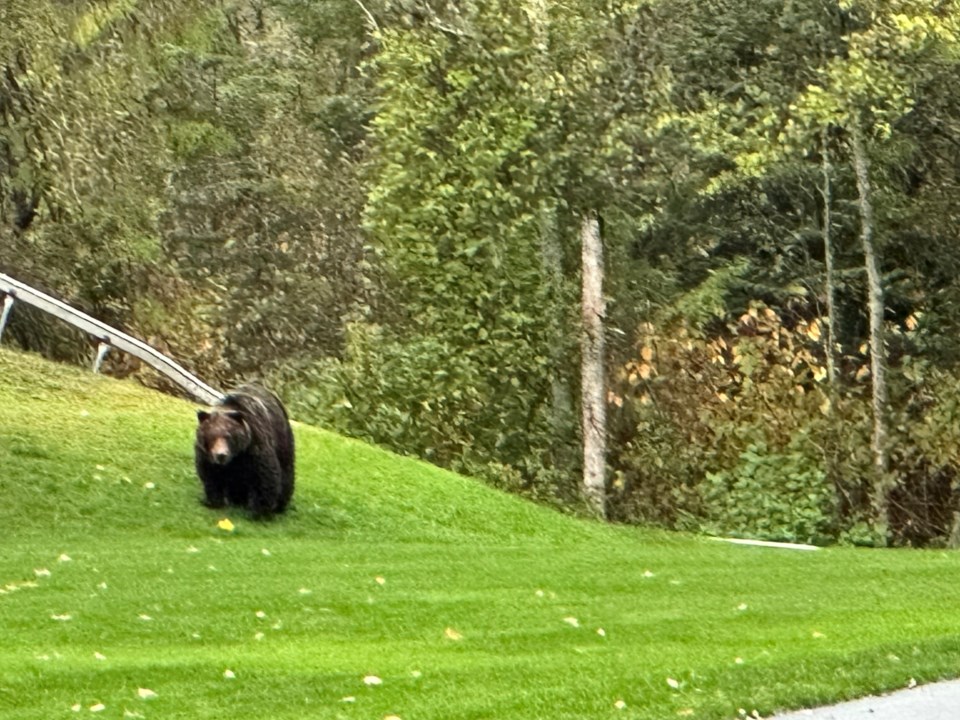When reports of a grizzly bear hanging around Whistler’s Myrtle Philip Community School began to surface in October 2023, many in the community were rightfully on edge.
But nearly two years later, the case is now held up by the Resort Municipality of Whistler as a coexistence success story.
“That was one of our first real interactions with the grizzly bear within our community,” said Dale Mikkelsen, general manager of climate action, planning and development services, in a presentation to the July 8 committee of the whole. “So we want to start telling that success story.”
The incident is a good example of how a community can coexist with wildlife, Mikkelsen said.
“Understanding there was a bear located near Myrtle Philip school, particularly around the Halloween period, engaging that community actively, giving that bear space to just do what a bear does, teaching the community about that, minimizing the number of lookers and people trying to observe the bear,” Mikkelsen said.
“The bear has now been tracked. It happily moved on, and is living its best bear life in the alpine sector, and that was through communication. So rather than having to say, tranquilize the bear, move the bear, or have the bear become a hazard bear, that spatial separation, that learning and education, the community allowed that bear to move on to its regular existence.”
It’s just one of several high-profile wildlife sightings in the resort in recent years, not all of which had such favourable outcomes. Mikkelsen referenced the incident in Kadenwood earlier this year, in which a mother bear was killed and three cubs abandoned after she attacked a woman walking her dog.
“There’s been a lot of learning from that and a lot of shared collaboration among the [Whistler Bear] Working Group, as well as among the folks who were a part of that story and those that care deeply about that story on the internet and social media,” Mikkelsen said. “So there’s been a lot of work in debriefing that action.”
The Whistler Bear Working Group—“a pretty diverse group of very knowledgeable individuals” that includes Conservation Officers, police, Whistler Blackcomb, waste management, AWARE, municipal staff, and members at large—meets monthly, and in 2024, its biggest task was reviewing the local grizzly bear mitigation strategy, Mikkelsen said.
Looking forward, the group aims to establish Whistler-specific bear-viewing guidelines.
“There’s a good collaboration with the bear-viewing operators in town, as well as consulting with the province,” Mikkelsen said. “And the goal here is to get those folks to all sign on to a standard set of guidelines and operating principles so that bears are treated with respect and we keep them happily in our community.”
One recent addition that may “seem like a novel little add-on, but it’s quite important,” is new Ministry of Transportation signage installed in the Callaghan, he added.
“We’re starting to have a lot of looky-lous driving up and down the Callaghan, as bears frequent the boulevards and sides of roads there, because things are delicious, especially early season,” Mikkelsen said. “And that signage has helped cars that are viewing bears understand that they just need to move along and let them snack in peace.”
The RMOW also plans to continue offering support with bear education and communication, and “that’s anywhere from schools to door-knocking in sort of bear-present communities, etc., and then input into community bear management best practices,” Mikkelsen said. “So we really need to be always getting better at debriefing our bear incidences, working with communities to identify those attractant issues, provide bear-sighting updates in a way that doesn’t mean, ‘Come look at the bears,’ but in a way that we understand how bears are moving through our community and our valley.”
After the presentation, Councillor Cathy Jewett noted the sharp increase in reports of a different animal this year.
“Are we limiting ourselves too much by just thinking about bears? Because there’s a new critter in town—the cougar. Actually, there’s been cougars here for a long time. And I mean, the feline type, of course,” Jewett quipped. “Has there been any thought about including them in some of our mitigation efforts and including them in the agenda of the Bear Working Group?”
Coun. Arthur De Jong, who sits on the Bear Working Group, gave a shout-out to Conservation Officers in Whistler.
“They never miss a meeting. They give us the essential information on recent wildlife conflicts, and in this case … they went in-depth in the meeting with respect to our current challenge with mountain lions,” De Jong said. “It is very unusual. I mean, [Jewett and I] both have a 40-plus, 50-year history here, and it’s just been the odd sighting. This is very unique, and our COs will provide whatever level of focus is required. And I feel our group is always well-advised by the COs.”




